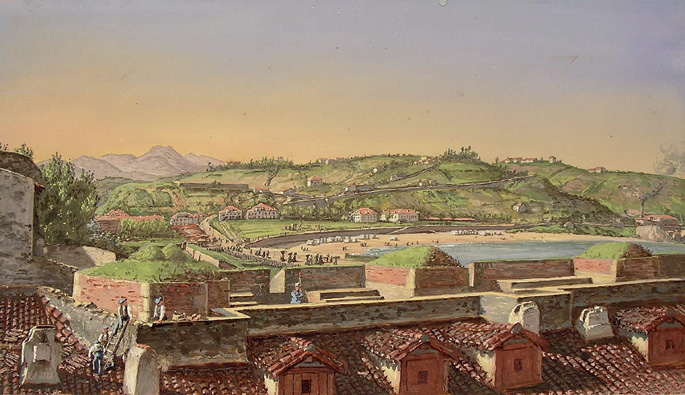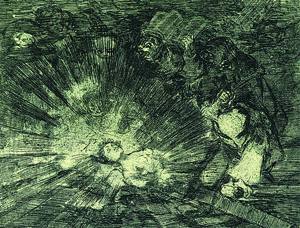Long hangover of August 31, 1813
- Although the Allies decided to rebuild the city at the Zubieta meeting a few days after the destruction of San Sebastian, the consequences of the disaster occurred in the following months and years. The Donostiarras had to cope with the reconstruction of the city without aid, looted and affected by epidemics.

The brief and simple account of the destruction of San Sebastian on August 31, 1813, usually has a happy ending in the Aizpurua farmhouse of Zubieta. On 8 and 9 September, several Donostiarras met there to respond to what happened a week earlier. Out, immediately, the city was seen as missing from the map. When La Gazeta de Madrid reported what happened, he added: “Only the memory of your location will remain from San Sebastian.” The congregants in Zubieta, on the other hand, decided to create a new city hall and rebuild the city; another thing was the execution of what was agreed.
If what happened at the end of August was sudden, crude, the winter disaster of 1814 was colder, slower, quieter, very different, but just as terrible.
No aid
On February 20, 1814, Mayor Gregorio Iturbe sent a letter to the Spanish Republic in which he regretted the lack of response and request for help. In the introduction, the letter said that San Sebastian was “the most unfortunate city in the world, almost without physical existence, and all at the end of its moral existence.” Iturbe and the other councillors assured that for five months they had endeavoured to publicize the situation of the city and get help, but the Congress had not responded to them until then. The authorities in Madrid ignored them for the third time. They also addressed those responsible for the destruction to ask for reconstruction aid or to collect the same rations as the soldiers ate. Generals Graham, Castaños and Alava did not respond. Wellington yes, he was a foreigner and didn't know anything about the country. In the days after the fire, there was no help to clean the remains of the buildings, so working groups were organized in the neighboring towns. Neither the Spanish Government nor its allies received compensation, subsidies or funding for the reconstruction of the city.
In the months after the destruction of the city, there were about 300 inhabitants inside the walls. Most Donostiarras lived in about 400 homes outside the city. But outside the walls, you couldn't rebuild the city. Between 1814 and 1817, the inhabitants of the outer neighborhoods did not obtain the authorization of the Ministry of War to rebuild their houses.
Symbolic support came in 1816. King Ferdinand VII declared himself a protector of the city. However, a communiqué of July 1824 states that the city still did not receive any compensation. The help of the king did not exceed the symbolic level on June 10, 1828, when the first stone of the City Hall of Plaza Nueva was placed.
Run over
Despite a passive attitude of help, the military leaders of the destruction were active in looting. Looting began before the fire was extinguished. The stolen money was sold at the height of the British barracks, while General Graham was turning a blind eye. On the same day, 4 September, the Council of Gipuzkoa requested in vain the lifting of the body of the young woman. The looting lasted for months. If the activity went down, it was because there was nothing left to steal. At the end of November, several owners of the San Martin neighborhood denounced the intention of an English officer to bring the sillares of their homes.
And in the spring of 1814, direct theft made way for the indirect hand of speculators who didn't have the scruples to do the business of tragedy. Before the fire they came to ask for EUR 12,000 for the warehouses of GBP 900 a year of rent they currently had. The rise in the price of bread in summer sparked protests.
While a few were enriched, the population lived in extreme poverty, without the possibility of safeguarding themselves from the cold of winter. Although the area was full of forests, there were no means of transporting wood. They even ran out of firewood to keep Igeldo's lighthouse on.
What was missing: malaria
The financial bankruptcy of the City Hall was total. There were no municipal doctors, no hospitals, so the Donostiarras were unprotected from diseases and epidemics. Juan Miguel Zatarain, owner of the river junk, also had no money to heal the swine, and found an ideal environment for the proliferation of anopheles mosquitoes. According to the chronicles of the time, in the winter of 200 years ago malaria caused between 8 and 10 deaths per day. More than a thousand Donostiarras died on arrival than allied soldiers. Although the City Hall immediately ordered Zatarain to clean the swamps, the obstinate and irresponsible owner brought the matter to court, and it took three years to heal the contagion and get rid of the epidemic.
And many more years to quell the consequences of the fire, to settle the incalculable debt deposited by the military and to implement what has been decided in Zubieta.
Donostia izan zen 1813ko udako biktima nagusia. Hango hondamendiak ez zuen parekorik izan. Baina frantziarren nahiz aliatuen gehiegikeriak Euskal Herriko beste hainbat tokitan ere izan zuten eragina.
Bilbo frantziarrek setiatu eta hartu zuten, Christophe-Antoine Merlin jenerala buru. Dozenaka hilketa eta bortxaketa izan ziren. Hainbat etxe erre zituzten, eta elizak, ondasun preziatuenak gorde ohi zituzten eraikinak, arpilatu zituzten.
Gasteizko gudua Arabako lautadan jokatu zen 1813ko ekainaren 20 eta 21ean. Bi aldeetan hildako asko izan ziren, gehiago tropa napoleonikoen artean. Baina zibilen kontra ez zuten errepresaliarik hartu. Hori bai, arpilaketa izugarria izan zen, gure lurraldean aurrekaririk gabekoa. Gudua irabazi ondoren Welligngtonek ez zuen esperotako expolioa egiterik izan. 275.000 libera inguruko balioa zuten ondasunak bildu zituen, baina altxorrik preziatuenak, hala nola Rafael, Velázquez, Tiziano, Rubens edo Zurbaranen ehunka koadro, frantziarrek eraman zituzten –gerora aliatuek berreskuratuko zituzten arren–. Soldaduei nahi adina arpilatzeko baimena eman zien jeneralak; Gasteiz eta inguruak doako azoka erraldoi bihurtu ziren tropentzat. Herritarrek ahal zutena soinean eramanda, presaka, alde egin zuten, eta bidean gehienek ondasun eskas horiek ere eman behar izan zituzten, bortxaketak eta hilketak saihesteko.
Abuztuaren 31n bertan, Irun inguruetan, San Martzialeko bigarren guduan, bi bandoetan hildako ugari izan arren, zibilen bajak urriak izan ziren. Herritarren kontrako errepresaliarik ez zen izan.
Baina hilketa, lapurreta edo bortxaketa sistematikoak egiteko baimen edo agindu “ofizialik” ez izateak ez du esan nahi albo-kalte latzak ez zeudenik. Esaterako, San Martzialeko guduaren biharamunean, handik galtzaile erretiratutako hainbat soldadu frantziarrek ingeles eliteko tiratzaile talde batekin topo egin zuten Alkaiaga (Lesaka) eta Bera lotzen dituen San Migel zubian; 200dik gora hildako izan ziren. Alegia, gudu handien itzalean nonahi gatazka txikiagoak sortzen zirela. Eta militarrak tiroka hasi gabe ere, zibilek haien igarotzea nozitu zutela. Frantziar tropek Baiona zuten inguruko base nagusia. Wellingtonek Lesakatik prestatu zuen Donostiako erasoa. Gasteizen galdu ondoren, tropa frantziarrak Iruñera erretiratzen hasi ziren, Baionarako bidea etenda zutelako, besteak beste Gometxan eta Agurainen geldialdiak eginez. Eta batzuek zein besteek, garaile nahiz galtzaile, ez zuten erreparorik, behar edo nahi zuten guztia baimenik gabe hartzeko.
Iritsi da berriz ere abuztuak 31. Donostiarrentzat data beltza. Egun horretan orain 202 urte, 1813an hiria suntsitu, 1.600 pertsona inguru hil, hiriko ia emakume guztiak bortxatu eta lapurreta erraldoia egin zuten espainiarren aliatu ziren armada ingeles eta portugesek.
Gerrek Suntsitutako Hirien Topaketak” antolatu dituzte Donostian, hilaren 21ean. Bizikidetza eta bakea ardatz, etorkizuna izango dute hizpide bertaratutakoek.
1813ko Donostiaren suntsiketa oroitzeko egitarau zabala prestatu dute abuztuaren 30 eta 31rako. “Biktima guztien ezagutza” dute oinarri ekintzek sarraskiaren 200. urteurrenean, historian galduta ez geratzeko.
Donostiako aldirietatik zuzendu zituen hiriari eraso egin zioten tropak, nahiz eta, Iruñeko frontean egon ahal izateko, azken erasoaldia Thomas Grahamen esku utzi. Sarraskitik bizirik ateratakoei laguntza ukatu zien, eta ez zuen bere gain hartu bere tropek hiriaren sute... [+]
Baileneko dukea, espainiar militar eta politikaria. Campo de Gibraltar-eko komandante jenerala zen 1808an, frantsesen inbasioa gertatu zelarik. Baileneko borrokan Duponten tropak azpiratu zituenez, behin-behinean frantsesak penintsulatik egotzi zituen; huraxe izan zen ordura... [+]
Carlos IV.aren balidoa. Bere jarduera profesional meteorikoa Carlos IV.a erregearen emaztearekin, Maria Luisa de Parmarekin, izandako erlazioarekin lotu da. Konbentzio Gerran Godoyk traizio bezala hartu zuen Donostia Moncey jeneral frantsesari errenditu izana. 1800an... [+]
Brigadako jenerala eta Donostiako gobernari militarra 1813an. Espainian 1808an sartu zen, Kataluniako armadaren Estatu Nagusiko buru. 1813an Donostiako gobernari militar izendatu zuten. Ugartemendia eta Jauregi San Bartolome gainera iritsi zirenean, donostiarrei haien bila... [+]
Espainiako erregea. Erresumaren ardura María Luisa de Parma andrearen eta Manuel Godoy balidoaren esku utzi zuen. 1808an, krisialdi politiko eta militarraren erdian, Fernando VII.a semearengan abdikatu zuen; baina Napoleon ados egon ez eta semea behartu zuen koroa... [+]
In the bicentennial of the San Sebastian fire, public institutions and associations aim to remember what happened and here we can find ourselves in 1813 of the San Telmo Museum. Exhibition The site, the fire and the reconstruction of San Sebastian. The sample is divided into... [+]
Hitz hauek idazten ari naizen unean, 199 urte atzera eginda, tragedia beltza bizitzen ari ziren Donostian, eta askok ordurako dena galdu zuten. Abuztuaren 31n sartu ziren tropa ingeles eta portugaldarrak hirian, eta hurrengo egunetan frantziarrak Urgull mendiko gotorlekura igo... [+]
Atzo Iñaki Egañaren Donostia 1813 liburuaren sarrera orokor bat egin nuen, eta blogerako artikulua luzeegi zihoala ikusita, hurrengo baterako utzi nuen Donostian gertatu zena ulertzeko azalpen eskematiko bat idaztea. Agian ez dira historia ulertzeko 10 punturik... [+]
















